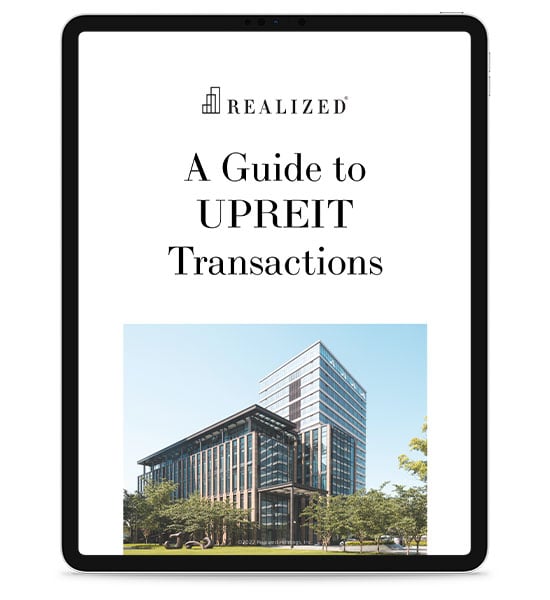
Investors have plenty of choices when it comes to the type of investment approach they take, particularly in the real estate sector. However, various options offer similar benefits, and some are so closely structured that confusion arises. Things can get complicated! Real estate investment trusts (REITs) and umbrella partnership real estate investment trusts (UPREITs) are two prominent examples.
These two investment vehicles both own underlying properties and generate income for interest holders. However, there are a few key distinctions between the advantages they offer and their ownership structures that make a world of difference. What is an UPREIT, and how does it differ from a traditional REIT? Realized 1031 is here to share all you need to know.
REIT 101: What Are Traditional REITs?
A REIT is a company and legal entity that owns, operates, and finances income-generating real estate assets. This structure removes responsibility and direct ownership for investors. Instead, they enter the REIT by purchasing REIT shares, which is akin to buying stocks. This way, an investor can gain exposure to the real estate market while avoiding the burden of active management.
There are three popular types of REITs today.
- Equity REITs own and operate income-generating properties like offices, apartments, or shopping centers. This is the most common type of REIT.
- Mortgage REITs invest in mortgages and mortgage-backed securities. These ones earn income from the interest of the underlying investments.
- Hybrid REITs combine both property ownership and mortgage investments.
There are a few rules that govern the operations of REITs. Among the most well-known is the 90% rule, which requires REITs to distribute at least 90% of their income to shareholders. This feature makes REITS appealing to investors focused on steady cash flow.
UPREITS and How They Work
UPREITs work similarly to REITs, which is unsurprising since REITs are a component of the former. What’s the difference? An UPREIT is a larger operating partnership (OP) composed of the REIT and the investors. You can become part of the UPREIT by contributing your assets to the OP in exchange for OP units. These units are the economic equivalent of REIT shares.
In this structure, the REIT has the controlling interest, and you’re a limited partner. As the underlying properties earn income, the REIT distributes dividends to each investor depending on the number of units they own.
What’s the point of creating an operating partnership? Contributing your assets to an operating partnership and receiving OP units is known as the 721 exchange, which could potentially allow you to defer capital gains taxes. The IRS doesn’t recognize gain or loss during this exchange, so you can delay tax liability and preserve more of your wealth. Unlike receiving REIT shares, which can trigger an immediate taxable event, OP units allow you to maintain your investment without incurring taxes in the year of the transaction.
UPREIT vs. Traditional REIT: Comparing Differences
Here are some of the definitive differences between these two types of investments.
Ownership Structure
- REIT: The REIT owns the underlying properties. Meanwhile, investors own REIT shares.
- UPREIT: The UPREIT owns the underlying assets through the operating partnership. The REIT and investors own OP units, but the former holds the bulk of the interests as the controlling partner.
Initial Investment
- REIT: Investors enter the REIT by purchasing shares with cash or selling their property to the REIT.
- UPREIT: To invest in an UPREIT, you’ll need to contribute your real estate asset and receive OP units based on the value of your properties.
Tax Treatment
- REIT: Selling your property to the REIT triggers a taxable event for any capital gains. If you sell your REIT shares and they appreciate, you’ll also have tax liability.
- UPREIT: Contributing your property through a 721 exchange allows you to defer capital gains taxes. Only when you convert your OP units to shares and sell them will you be liable to pay tax.
Control
- REIT: In a traditional REIT structure, only the REIT has control over the operations and management of the properties.
- UPREIT: The same applies to UPREITs since the REIT has the controlling interest. Both offer hands-off involvement and passive income for the investors. However, there are some UPREITs that allow certain partnership rights or restrictions for the owners of contributed properties.
Liquidity Timeline
- REIT: Since REIT shares are publicly traded, you can sell them at any time.
- UPREIT: Most UPREITs have a holding period of at least one year before you can convert OP units.
Exit Strategies
- REIT: You exit the REIT by selling REIT shares in the market for cash.
- UPREIT: After the holding period, you can convert your OP units to REIT shares, then trade or sell them. This step creates a taxable event, and the deferred taxes, along with any gain your OP units made, will be subject to capital gains taxes.
Benefits of UPREITs
UPREITs offer unique advantages that you may not encounter with REITs and other types of investments.
Tax Deferral
The main benefit of UPREITs is the tax deferral. This advantage is especially appealing to those nearing retirement who have highly appreciated properties. Contributing their assets to the UPREIT allows them to preserve more of their retirement funds and avoid major tax hits.
Passive Income
Both REITs and UPREITs remove direct control of properties from investors. Those who no longer want the burden of direct management over their properties will find this benefit a major advantage.
Enhanced Diversification
Many UPREITs own multiple properties across various geographic locations. While some specialize in sectors like multifamily housing or retail, there are others that hold assets from several sectors. These features help diversify your portfolio and provide additional cushion against market downturns.
Professional Management
REITs are usually established companies with experts and systems that allow them to expertly handle the operations and management of the UPREIT. Direct ownership won’t provide such an advantage.
Step-up in Basis
If you hold your OP units until your passing, they undergo a step-up in basis that resets their cost basis to their fair market value upon your death. Thanks to this benefit, your heirs can enjoy some tax relief. Shares from traditional units also undergo a step-up in basis, but since they don’t carry the deferred capital gains as OP units do, the reduced tax isn’t as substantial.
Potential Drawbacks and Risks to Consider
What are some of the challenges and possible pitfalls associated with UPREITs? Here are some of what you should watch out for.
- Lack of Control: By contributing your asset to an UPREIT, you relinquish control over it. This effect may not be appealing to those who still want to maintain some level of involvement over their property.
- OP Unit Conversion Holding Period: Unlike traditional REITs, you may need to wait at least one year before you can convert and liquidate OP units. Those who foresee the need for liquidity in the near future may find UPREITs limiting.
- Tax Liability: Upon converting and selling OP units, you will be liable to all the deferred capital gains taxes from your previous property, as well as any appreciation of your OP units. It’s a common practice for investors to convert OP units in increments to manage tax liability.
When Is an UPREIT Right For You?
Here are a few scenarios where UPREITs are an ideal avenue for investors.
- Highly Appreciated Assets: Having a property that has doubled or tripled in value since you acquired it leaves you susceptible to substantial capital gains taxes. Contributing the asset to an UPREIT can be part of your tax management strategy, helping you keep more of your wealth for longer.
- During Estate Planning: OP units are much easier to divide among heirs compared to properties you directly own. As such, many investors leverage UPREITs to make wealth transfer easier.
- Comfort With Long-term Investment: UPREITs are best suited for property owners or investors with a long-term outlook. They offer tax-deferred diversification and income potential, but liquidity often comes later. Those comfortable holding OP units for several years can benefit from professional management, portfolio growth, and eventually the flexibility to convert into REIT shares when the timing is right.
Wrapping Up: REIT vs. UPREIT for Real Estate Investors
In summary, a REIT is a legal entity that owns real estate assets, while UPREITs are operating partnerships controlled by REITs. Tax deferral is the main benefit of UPREITs that you don’t encounter in traditional REITs, making the former popular for investors who want to preserve their capital for longer.
Regardless of the method you choose to invest in, in-depth research and professional guidance remain essential. With sufficient knowledge, you can confidently enter either option and increase the chances of maximum ROI.
Sources:
https://www.investopedia.com/terms/u/upreit.asp



